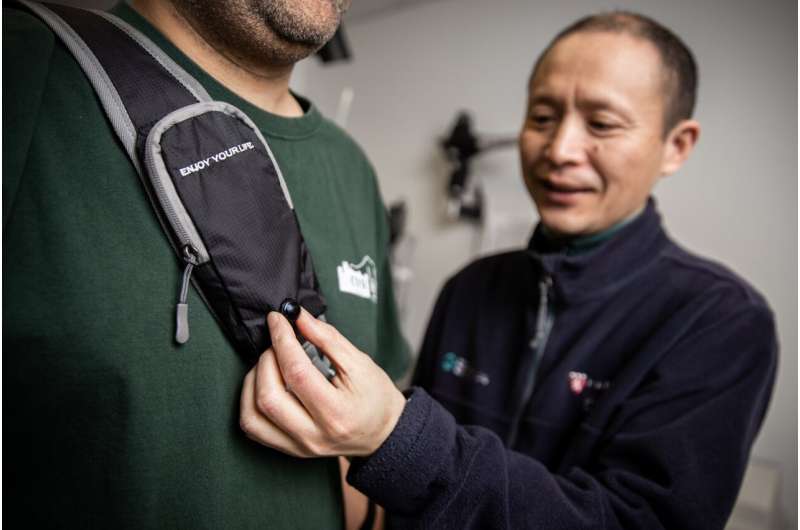Wearable devices can reduce collision risk in blind and visually impaired people

A new study showed that a wearable computer vision device can reduce collisions for both people who are blind or those who are visually impaired and using a long cane and/or guide dog by 37 percent, compared to using other mobility aids alone.
People who have visual impairments are at a significantly higher risk for collisions and falls. Commonly used mobility aids like long canes and guide dogs can offer benefits, but come with limitations in effectiveness and costs, respectively. While some electronic devices are marketed direct-to-consumer claiming to warn wearers of surrounding objects, there has been little evidence of their effectiveness in actual daily mobility settings. This is one of the first randomized-controlled trials to look at the potential benefit of the devices at home and outside of a controlled lab environment. The new study led by vision rehabilitation researchers at Mass Eye and Ear, a member of Mass General Brigham was published July 22 in JAMA Ophthalmology.
“Independent travel is an essential part of daily life for many people who are visually impaired, but they face a greater risk of bumping into obstacles when they walk on their own,” said Gang Luo, Ph.D., an associate scientist at the Schepens Eye Research Institute of Mass Eye and Ear, and an associate professor of ophthalmology at Harvard Medical School. “Although many blind individuals use long canes to detect obstacles, collision risks are not completely eliminated. We sought to develop and test a device that can augment these everyday mobility aids, further improving their safety.”

Vibrating wearable device prototype put to test
The experimental device used in the trial was created by Dr. Luo and colleagues in his vision rehabilitation lab, including the lead author Shrinivas Pundlik, Ph.D., who designed the computer vision algorithm. The device and data recording unit were enclosed in a sling backpack with a chest-mounted, wide-angle camera on the strap, and two Bluetooth-connected wristbands worn by the user. The camera is connected to a processing unit that captures images and analyzes collision risk based on the relative movement of incoming and surrounding objects in the camera’s field of view. If an imminent collision is detected on the left or right side, the corresponding wristband will vibrate; a head-on collision will cause both wristbands to vibrate. Unlike other devices that simply warn of nearby objects whether or not a user is moving toward the objects, this device analyzes relative motion, warning only of approaching obstacles that pose a collision risk, and ignoring objects not on a collision course.
The new study included 31 blind and visually impaired adults who use either a long cane or guide dog (or both) to aid their daily mobility. After being trained to use the device, they used it for about a month at home in conjunction with their typical mobility device (mostly a long cane). The device was randomized to switch between active mode, in which the users could receive vibrating alerts for imminent collisions, and silent mode, in which the device still processed and recorded images, but did not give users any warning even if potential collisions were detected. The silent mode is equivalent to the placebo condition in many clinical trials testing drugs. The wearers and researchers would not know when the device modes changed during the testing and analysis. Collisions were analyzed by researchers from the recorded videos. The effectiveness of the device was evaluated by comparing collision incidents that occurred during active and silent modes. The study found that the collision frequency in active mode was 37 percent less than that in silent mode.

Providing a new option for the visually impaired
Long canes are one of the most effective and affordable mobility tools for a person who is blind or visually impaired, but they have limitations. Canes primarily detect hazards on the ground that are within reach; however, hazards above ground level are often missed. Additionally, the range of long cane sweeping can be restricted in busy environments, such as cities, in order avoid hitting nearby pedestrians. Guide dogs are highly effective, but hard to come by and cost-prohibitive for many, as training a guide dog typically costs $45,000-$60,000. A chest-mounted, collision-warning device could provide an option to help people avoid overhanging or moving obstacles that pose challenges to long cane users, Dr. Luo explained.
Alex Bowers, Ph.D., a clinical researcher and one of the co-authors of the paper, added that the video recording from the study also provides rich data about daily life mobility of people with visual impairments. This can, in turn help researchers better understand the challenges of collision detection in this population.
“Long canes are still very helpful and cost-effective tools that work well in many situations, but we hope a wearable device like this can fill in the gaps that the cane might miss, providing a more affordable, easier to obtain option than a guide dog,” Dr. Bowers said. “The insights provided by our data can be valuable for improving mobility aid training.”
Next, Dr. Luo and his team seek to leverage ongoing improvements in mobile processing power and cameras to make the device smaller and more cosmetically appealing. With additional funding, the team hopes that such a device could be submitted to the U.S. Food and Drug Administration for approval so that it could be commercially available for people with low vision.
Source: Read Full Article


